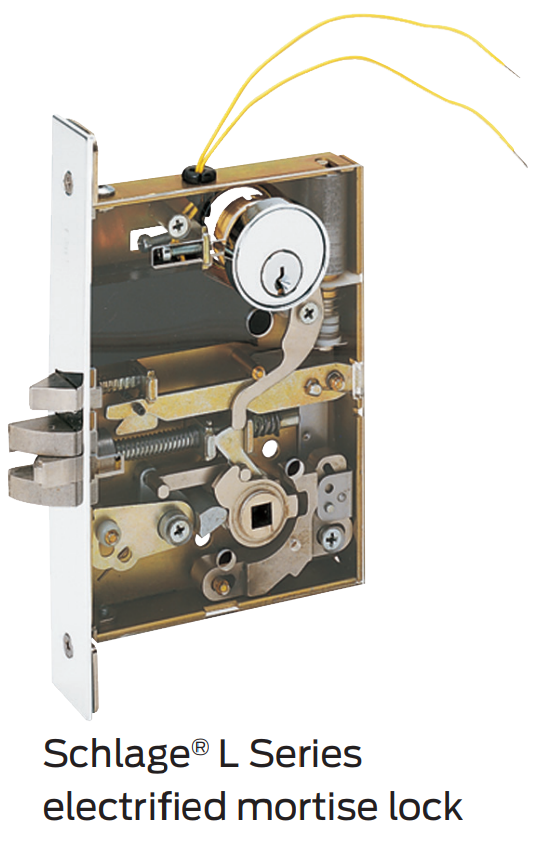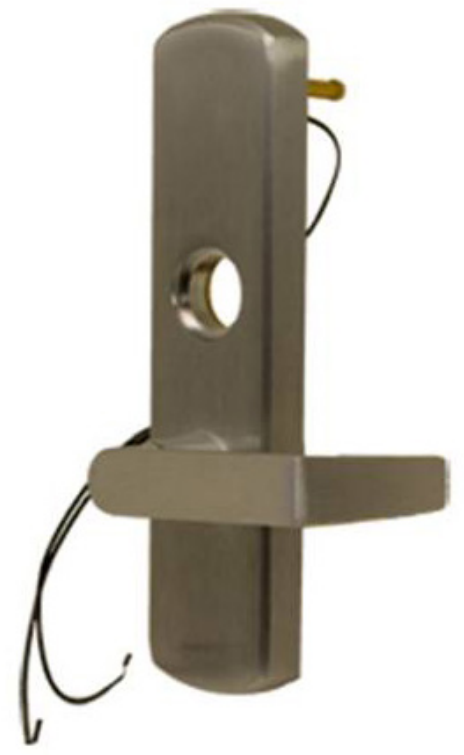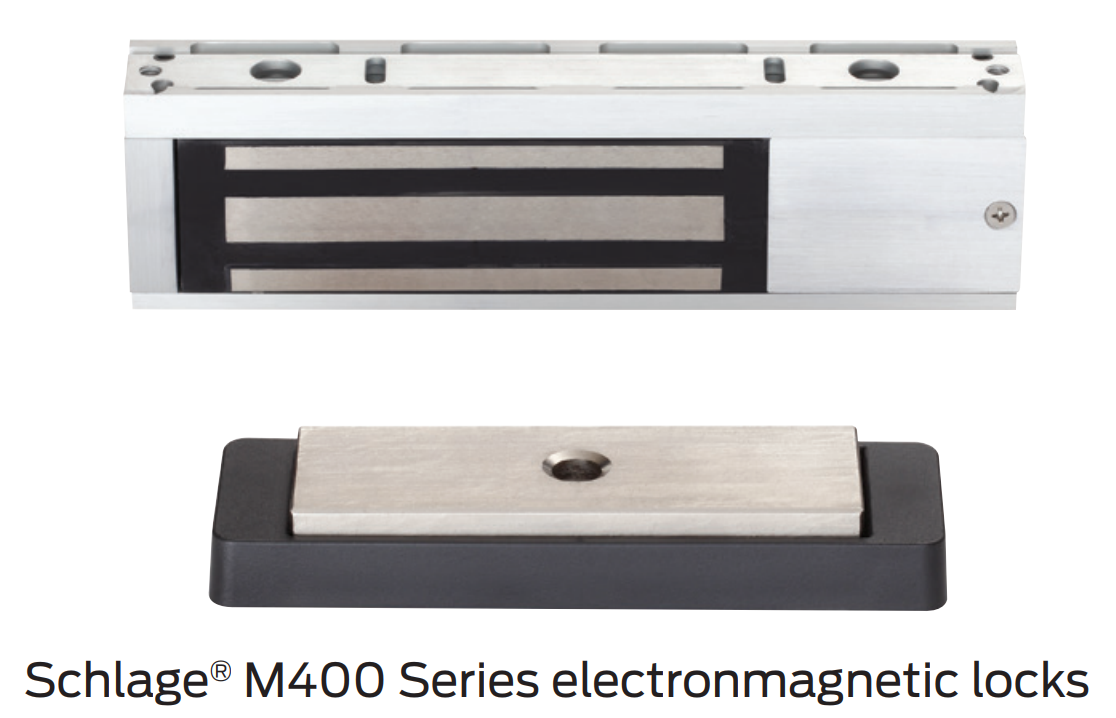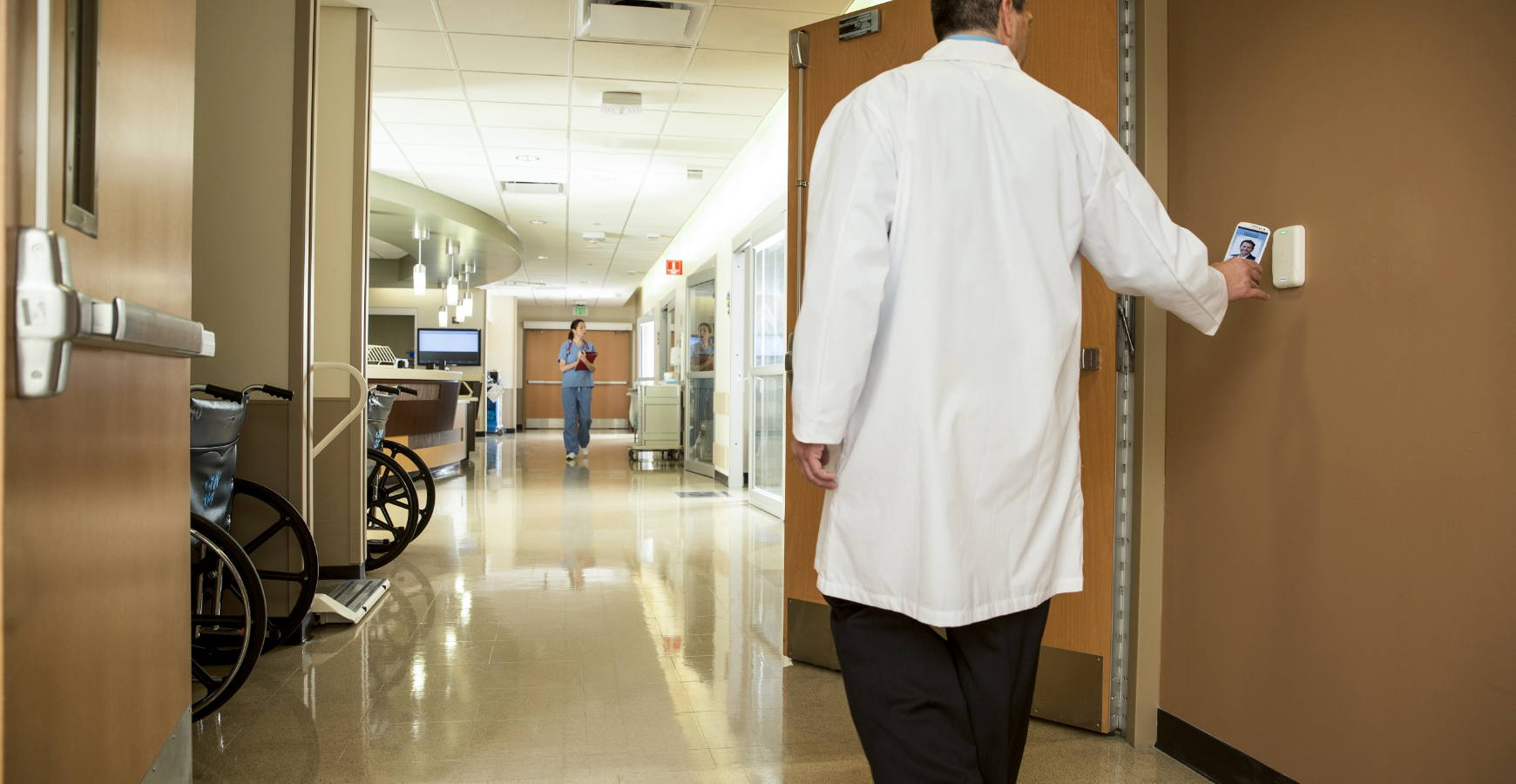Electric strikes
An electric strike replaces the regular strike for a lockset or panic hardware. For a single door, it mounts in the frame and for a pair, it mounts in the inactive leaf or on a mullion. The lockset or panic hardware still functions as it normally would—free egress is available at all times, except in the case of double-cylinder institutional function locks.
The spring-loaded keeper on the electric strike controls the latchbolt of the lock or panic hardware. When access is allowed, the keeper is free and the latchbolt can be pulled through the keeper so the door can be opened. When the strike is secure, the keeper secures the latchbolt and prevents the door from being opened from the outside. In most cases, a key can be used to retract the latchbolt from the secure side of the door to allow access if a manual override is needed. And because the lock or panic hardware functions independently of the electric strike, you can exit by turning the lever or pushing the touchpad of the panic hardware, regardless of whether the electric strike is fail safe or fail secure.
For electric strikes on fire-rated doors, fail secure strikes must be used because fail safe strikes do not provide the positive latching and the listings required by NFPA 80–Standard for Fire Doors and Other Opening Protectives. I specify fail secure strikes in almost all applications, except when access is required upon fire alarm. There are very limited situations where access upon fire alarm is required (see below regarding stairwell re-entry). I have been asked, “What about firefighter access?” The use of an electric strike really doesn’t change anything in regard to firefighter access. Their method for access on a door with a mechanical lockset can still be used. That might be a key or access-control credential in the key box or a tool, depending on what type of hardware is on the door.
|  |
You might think, “Let’s just make all electrified products fail safe so then I know there won’t be a problem.” Well, don’t forget that electric strikes on fire doors must be fail secure so the door is positively-latched if there is a fire. But in addition, there are security concerns. Should the building or area be unlocked and allow free access every time there is a power failure? A breach of security can be extremely dangerous for building occupants, along with the potential for loss or damage. That’s not a liability I’m willing to take on.
Electromechanical locks
An electromechanical lock is a lockset which has been electrified so that it can be controlled by a card reader, remote release or other access control device. Most electromechanical locksets allow free egress at all times. There are double-cylinder electromechanical locksets which do not allow free egress, just like a double-cylinder mechanical lockset, but neither of those should be used on any door that is required for egress. Note that when you see a lock Von Duprin® 6200 Series electric strike Schlage® L Series electrified mortise lock with two key cylinders, it may be a classroom security lock, which allows free egress, not an institutional function lock, which does not allow free egress.
 | A fail secure electromechanical lockset is locked on the secure side when there is no power to the lock. To unlock it, power is applied and the lever can then be turned to retract the latch. The latch remains projected until the lever is turned.
A fail safe electromechanical lockset is locked when power is applied and unlocked when power is removed. When power is removed, the lever can be turned to retract the latch. Fail safe electromechanical locks are used for stairwell doors providing re-entry. The lock is constantly powered so that the lever on the stair side is locked. During a fire alarm, the lever on the stair side is unlocked (power removed) either by the fire alarm or a signal from the fire command center, depending on which code has been adopted. Building occupants may then leave the stair to find another exit if necessary. The stair doors would also be unlocked during a power failure. The locks always allow free egress into the stair, with the exception of the stair discharge door, which can be mechanically or electrically locked on the outside but allows egress out of the stairwell.
|
Electrified panic hardware trim
Electrified panic hardware trim refers to the outside lever on panic hardware or fire exit hardware. It operates the same way that an electromechanical lock does—the power controls whether the outside lever can be turned or not. The latch remains projected until the lever is turned, and free egress is always available by pushing the touchpad or crossbar of the panic hardware.
Fail safe electrified trim for fire exit hardware (panic hardware listed for use on fire doors) is used for stairwell doors providing re-entry. Most other doors are not required to allow access upon fire alarm, so I typically use fail secure electrified panic hardware trim in locations other than stairwells. Keep in mind that most codes do not require the stair discharge door to unlock upon actuation of the fire alarm. The door between the stairwell and the roof may be required, or desired, to be fail safe. This is not typical and is not a requirement of the International Building Code or NFPA 101–The Life Safety Code. I have only worked on a few projects during my career where the path of egress led onto the roof.
|  |

Electric latch retraction
Electric latch retraction (EL/QEL) is a function typically used on panic hardware or fire exit hardware. EL devices, or QEL for the Von Duprin “Quiet” EL, are only available fail secure. When power is applied, the latch retracts automatically and stays retracted as long as power is applied. When power is removed, the latch is projected, securing the door. Again, free egress is provided via the touchpad of the panic hardware. EL/QEL devices are sometimes used on fire doors to allow push/pull function during normal use and provide positive latching during a fire alarm. A signal from the fire alarm system to the power supply is needed.
EL devices are often used with automatic operators, so the latch is retracted before the door begins to open. Electric strikes can perform this function as well. Fail safe or fail secure products can be used in this application, but I typically use fail secure except in the very rare case where access is required upon fire alarm. Electromechanical locks and electrified panic hardware trim are not used with automatic operators because the latch is not retracted until someone turns the lever, which would prevent the auto operator from opening the door.
Electromagnetic locks
An electromagnetic lock is an electromagnet which mounts on the frame with a steel armature mounted on the door. When you apply power to the magnet, it bonds to the armature, securing the door. Electromagnetic locks are only available fail safe. When you remove power, the electromagnetic lock unlocks.
 | Because mag-locks do not provide free egress like other electrified hardware, release devices are required by code in order to allow egress. An electromagnetic lock that is released by door-mounted hardware, like a request-to-exit switch in panic hardware, is required to unlock upon loss of power. If the electromagnetic lock is released by a sensor, it must also unlock upon actuation of a push button located beside the door, upon actuation of the fire alarm or sprinkler system and upon loss of power.
|
Summary
- Fail safe locks should be used on stairwell doors requiring re-entry and any other doors which must allow free access upon fire alarm or power failure.
- Fail safe electric strikes can’t be used for stairwell re-entry because fire doors require fail secure electric strikes for positive latching. Fire doors do not require fail secure electric locks—only fail secure electric strikes.
- Be aware that when a fail-safe product is used, the door will be unlocked whenever there is a fire alarm or power failure, which is an obvious security risk.
- Electric latch retraction panic hardware is only available fail secure—the latch projects when power is removed.
- Electromagnetic locks are only available fail safe—there is no magnetic bond when power is removed.
- Fail secure products are more common than fail safe due to security concerns. Power consumption may also be an issue. Fail secure products provide security when there is no power applied.
- Most electrified products, with the exception of electromagnetic locks, allow free egress at all times, regardless of whether they are fail safe or fail secure.
About the Author
Lori Greene, DAHC/CDC, CCPR, FDAI, FDHI is the Manager of Codes & Resources for Allegion. For more information about this topic and to download a free reference guide on codes, visit iDigHardware.com/guide



































